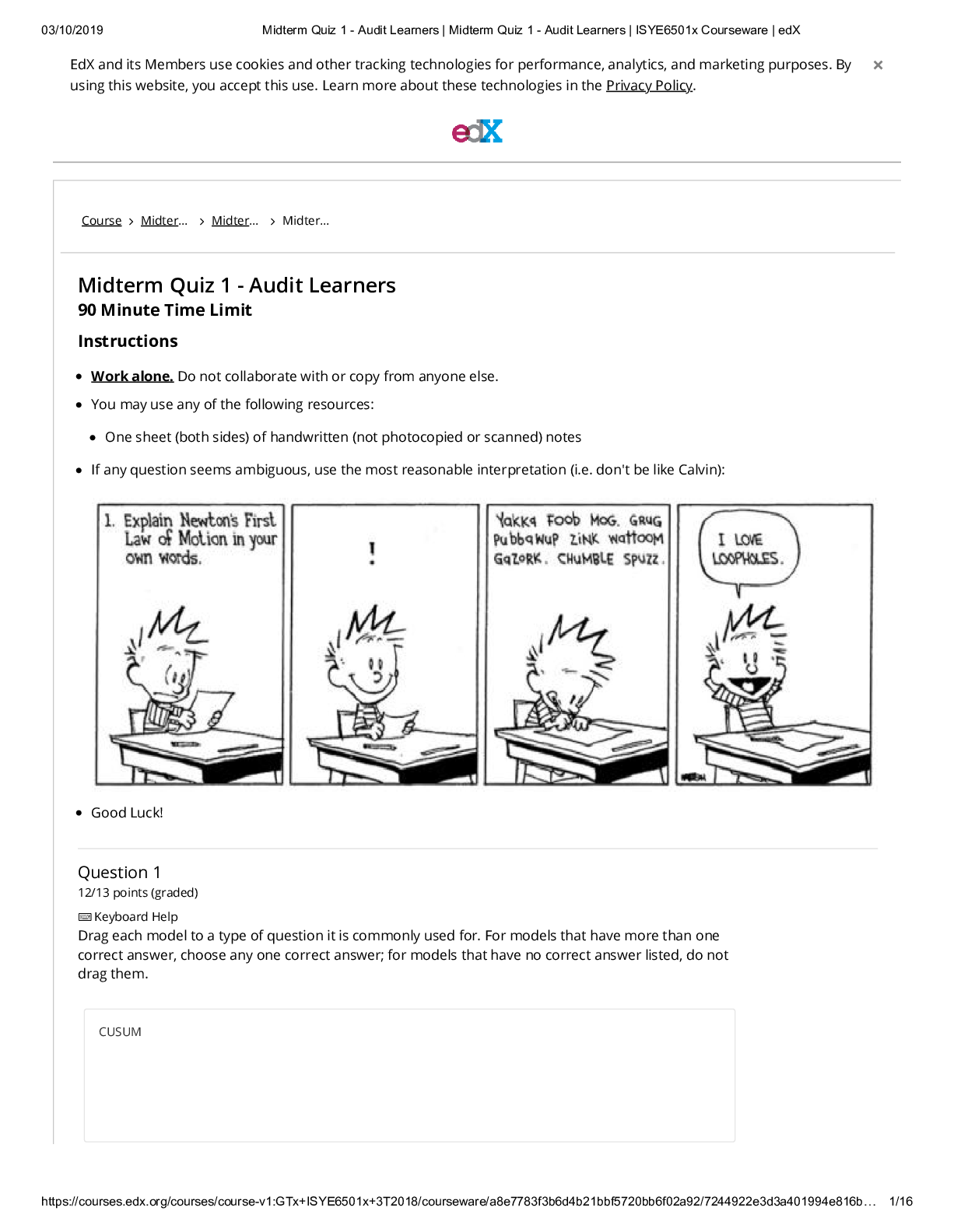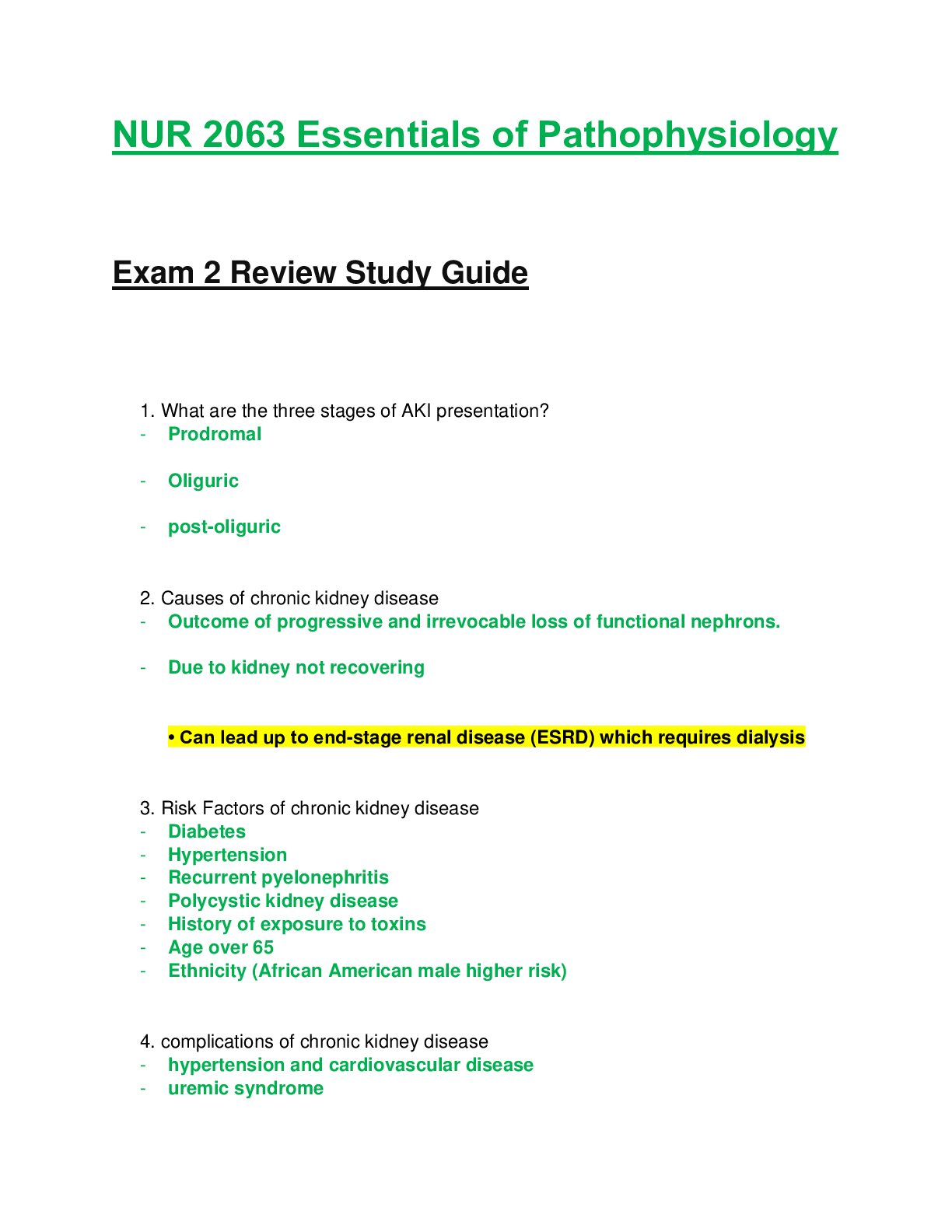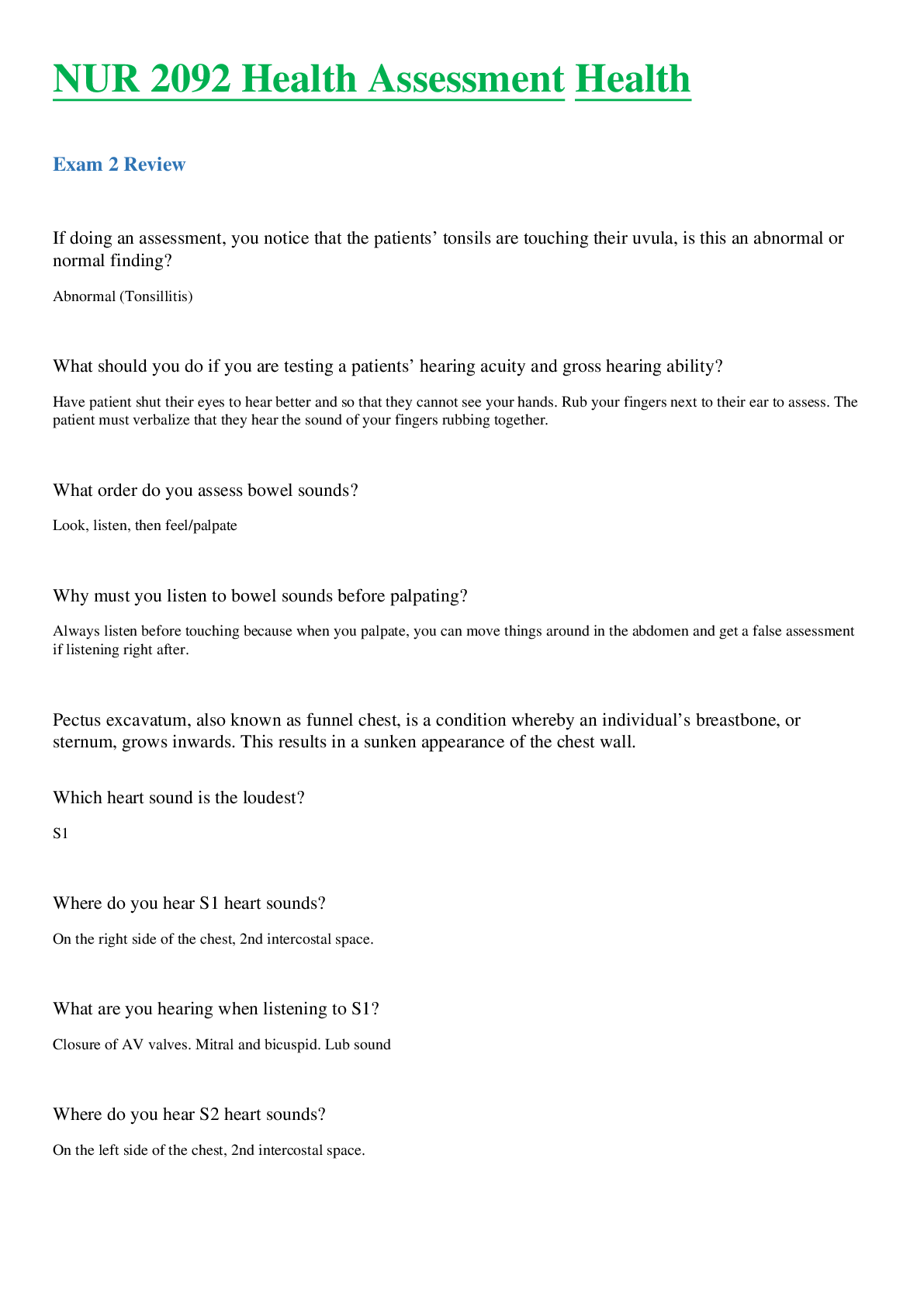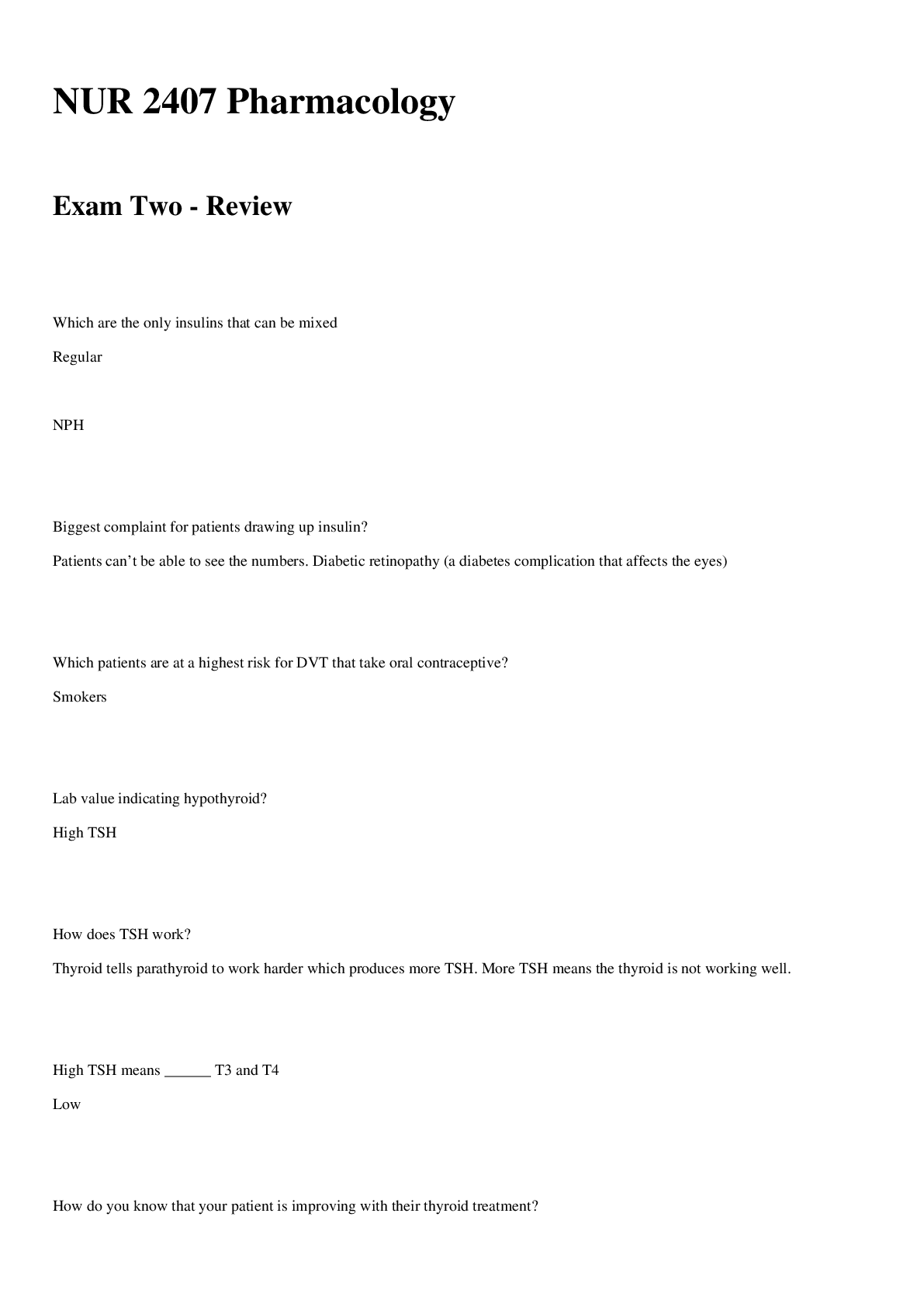*NURSING > EXAM REVIEW > Health Assessment Exam 2 Review Questions with correct answers (All)
Health Assessment Exam 2 Review Questions with correct answers
Document Content and Description Below
Health Assessment Exam 2 Week 5 Review Questions: 1. A palpable vibration increased with lobar pneumonia is also known as: 2. Your patient is exhibiting rapid shallow breathing, with a respirator... y rate > 24 respirations per minute. Which of the following conditions are they experiencing? 3. Which of the following terms is used to describe a decreased level of oxygen (O2) in the blood? 4. Upon receiving the patient’s lab results, the nurse notes the patient has an increased level of carbon dioxide in the blood. Which of the following conditions would the patient be experiencing? 5. The nurse is auscultating a patient’s lungs and hears discontinuous, high-pitched, short, popping sounds heard during inspiration, and not cleared by coughing. These are described as: 6. The nurse is assessing a patient’s lungs by using the percussion technique. Which sound would the nurse expect to hear over healthy lung tissue? 7. A clinical manifestation common in an individual with chronic obstructive pulmonary disease (COPD) is 8. Which of the following are functions of the respiratory system? (Select all that apply) 9. Stridor is a high pitched, inspiratory crowing sound commonly associated with 10. Which of the following correctly expresses the relationship to the lobes of the lungs and their anatomic position? 11. The function of the trachea and bronchi is to 12. Which of the following chest configurations is an exaggerated posterior curvature of the thoracic spine that is associated with aging and physical fitness? 13. The nurse is observing the auscultation technique of another nurse. The correct method to use when progressing from one auscultatory site on the thorax to another is _______ comparison. 14. The nurse is listening to the breath sounds of a patient with severe asthma. Air passing through narrowed bronchioles would produce which of these adventitious sounds? 15. A patient has been admitted to the emergency department with a possible medical diagnosis of pulmonary embolism. The nurse expects to see which assessment findings related to this condition? Week 6 Review Questions: 1. Freshly oxygenated blood enters the heart through the ___, and is pumped out to the body through the ____. 2. When listening to heart sounds, the nurse knows that the valve closures that can be heard best at the base of the heart are: 3. The nurse is asking the client for subjective data before performing a cardiac and great vessel assessment. Which of the following should the nurse ask? Select all that apply 4. The nurse is teaching the patient about health promotion of the cardiovascular system. Which of the following statements would indicate a need for further teaching? “I would like some information about ways to help me quit smoking.” 5. How should the nurse document mild, slight pitting edema on the ankles of a heart failure patient? 6. The nurse is educating the client about risk factors for cardiovascular disease. Which of the following risk factors for cardiovascular disease are modifiable? Select all that apply. 7. Which of the following is an appropriate position to have the patient assume when auscultating for extra heart sounds or murmurs? 8. Which statement is true regarding the arterial system? A 9. When assessing a patient the nurse is unable to palpate the left dorsalis pedis pulse. What should the nurse do first? 10. A 67-year-old patient states that he recently began to have pain in his left calf when climbing the 10 stairs to his apartment. This pain is relieved by sitting for approximately 2 minutes; then he is able to resume his activities. The nurse interprets that this patient is most likely experiencing: . 11. The nurse is preparing to perform a modified Allen test. Which is an appropriate reason for this test? 12. In assessing the carotid arteries of an older patient with cardiovascular disease, the nurse would: 13. When auscultating over a patient’s femoral arteries, the nurse notices the presence of a bruit on the left side. The nurse knows that bruits: Week 7 Review Questions: 1. The nurse is performing an assessment on a client. Which of the following should the nurse ask to obtain subject data related to the client’s gastrointestinal system? 2. The nurse is caring for a client who reports having abdominal pain. After inspecting the client’s abdomen, the nurse would be correct in performing what assessment technique? 3. The nurse is teaching a client about health promotion of the gastrointestinal system. Which of the following statements would indicate a need for further teaching? 4. A nurse is performing an assessment on a client. Which of the following statements demonstrates her understanding of the rationale for correct sequencing for an abdominal assessment? 5. A nurse is performing an abdominal assessment. The nurse correctly observes the following assessment findings when inspecting a client’s abdomen. Select all that apply. 6. During an abdominal assessment, the nurse is unable to hear bowel sounds in a client’s abdomen. The nurse understands that before reporting this finding as “absent bowel sounds” it is important to listen for at least _____ in each quadrant. 7. A nurse is performing an assessment on a client who reports abdominal pain. Which of the following actions should the nurse implement to promote relaxation of the client’s abdomen during the assessment? 8. The nurse is aware that one change that may occur in the gastrointestinal system of an aging client is: 9. The nurse is performing percussion by tapping on a client’s abdomen in the left upper quadrant (spleen) and right upper quadrant (liver). Which of the following would be an expected assessment finding in these two areas of the GI system? 10. During an assessment, the nurse notices that the client’s umbilicus is enlarged and everted. The nurse recognizes this as: 11. The nurse is preparing to examine a client who reports right lower abdominal pain. The nurse’s priority would be to: 12. The nurse is assessing a client's abdomen. She places the diaphragm of the stethoscope in the area where bowel sounds are prominent which is: 13. In performing a breast examination, the nurse knows that examining the upper outer quadrant of the breast is especially important. The reason for this is that the upper outer quadrant is: 14. The nurse is teaching a client about risk factors for breast cancer. She correctly includes which of the following risk factors? 15. During a breast health assessment, the client states that she has noticed pain in her left breast. An appropriate response to this by the nurse would be: 16. During an annual physical examination, a 43-year-old client states that she does not perform monthly breast self-examinations (BSEs). She tells the nurse that she believes that mammograms “do a much better job than I ever could to find a lump.” The nurse should explain to her that: 17. During an examination of a client, the nurse notices that her left breast is slightly larger than her right breast. Which of these statements is true about this finding? 18. During the physical examination, the nurse notices that the client has an inverted left nipple. Which statement regarding this is most accurate? ………………………………………CONTINUED………………………………………….. [Show More]
Last updated: 2 years ago
Preview 1 out of 15 pages
.png)
Buy this document to get the full access instantly
Instant Download Access after purchase
Buy NowInstant download
We Accept:

Reviews( 0 )
$14.00
Can't find what you want? Try our AI powered Search
Document information
Connected school, study & course
About the document
Uploaded On
Feb 18, 2021
Number of pages
15
Written in
Additional information
This document has been written for:
Uploaded
Feb 18, 2021
Downloads
0
Views
116

























